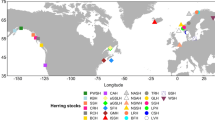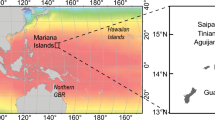Abstract
The scombrids (tunas, bonitos, Spanish mackerels and mackerels) sustain some of the most important fisheries in the world and their sustainable management depends on better understanding of their life history strategies. Here, we first assemble life history information on maximum size, growth, longevity, maturity, fecundity and spawning duration and interval for all scombrid species. Second we characterize their life history patterns and trait co-variation and evaluate how many principal axes of trait variation underlie scombrid life history strategies. Most of their life history variation can be explained along three axes or dimensions: size, speed, and reproductive schedule. Body size governs the first axis ranking species along a small-large continuum. The second axis was mostly influenced by time-related traits, such as longevity, growth rates, spawning duration, time between spawning events, ranking species along a slow-fast continuum of life histories. Scombrid species with the slowest life histories such as Atlantic bluefin tuna Thunnus thynnus and Atlantic mackerel Scomber scombrus tend to inhabit more temperate waters while species with faster life histories such as yellowfin tuna Thunnus albacares and short mackerel Rastrelliger brachysoma are typically found in more tropical waters. The third axis comprises the negative relationship between number of eggs produced at length of maturity and rate in gain of fecundity with size describing the schedule of reproductive allocation which reflects a fundamental trade-off between reproduction and growth. Finally, in addition we show that the life history strategies of scombrids conform more closely to the Periodic and Opportunistic strategists within the triangular model of fish life histories.






Similar content being viewed by others
References
Beverton RJH (1992) Patterns of reproductive strategy parameters in some marine teleost fishes. J Fish Biol 41:137–160
Beverton RJH, Holt SJ (1959) A review of the lifespans and mortality rates of fish in nature and the relation to growth and other physiological characteristics. In: Wolstenholme GEW, O’Connor M (eds) Ciba Foundation Symposium—The Lifespan of Animals (Colloquia on Ageing), vol 5. J. & A. Churchill Ltd, London, pp 142–180
Bielby J, Mace G, Bininda-Emonds O, Cardillo M, Gittleman J, Jones K, Orme C, Purvis A (2007) The fast-slow continuum in mammalian life history: an empirical reevaluation. Am Nat 169(6):748–757
Blanck A, Lamouroux N (2007) Large-scale intraspecific variation in life-history traits of European freshwater fish. J Biogeogr 34:862–875
Block BA, Finnerty JR (1994) Endothermy in fishes: a phylogenetic analysis of constraints, predispositions, and selection pressures. Environ Biol Fishes 40:283–302
Block BA, Teo SLH, Walli A, Boustany A, Stokesbury MJW, Farwell CJ, Weng KC, Dewar H, Williams TD (2003) Electronic tagging and population structure of Atlantic bluefin tuna. Nature 2795:109–112
Boyce D, Tittensor D, Worm B (2008) Effects of temperature on global patterns of tuna and billfish richness. Mar Ecol Prog Ser 355:267–276
Brown JH, Sibly RM (2006) Life-history evolution under a production constraint. Proc Natl Acad Sci USA 103:17595–17599
Brown JH, Gillooly JF, Allen AP, Savage VM, West GB (2004) Toward a metabolic theory of ecology. Ecology 85(7):1771–1789
CCSBT (2009) Report of the Fourteenth Meeting of the Scientific Committee, Busan, 5–11 September 2009, CCSBT
Charnov EL (2008) Fish growth: bertalanffy k is proportional to reproductive effort. Environ Biol Fishes 83:185–187
Claereboudt MR, McIlwain JL, Al-Oufi HS, Ambu-Ali AA (2005) Patterns of reproduction and spawning of the kingfish (Scomberomorus commerson, Lacépède) in the coastal waters of the Sultanate of Oman. Fish Res 73:273–282
Claudet J, Osenberg CW, Domenici P, Badalamenti F, Milazzo M, Falcón JM, Bertocci I, Benedetti-Cecchi L, García-Charton Ja, Goñi R, Borg Ja, Forcada A, De Lucia Ga, Perez-Ruzafa A, Afonso P, Brito A, Guala I, Le Diréach L, Sanchez-Jerez P, Somerfield PJ, Planes S (2010) Marine reserves: fish life history and ecological traits matter. Ecol Appl 20:830–839
Collette BB, Nauen CE (1983) FAO Species Catalogue. Vol. 2. Scombrids of the world: an annotated and illustrated catalogue of tunas, mackerels, bonitos and related species known to date. FAO Fisheries Synopsis No 125. FAO, Rome
Collette BB, Reeb C, Block BA (2001) Systematics of the tunas and mackerels (Scombridae). In: Block BA, Stevens ED (eds) Tuna: Physiology, Ecology, and Evolution, vol Fish Physiology 19. Academic Press, San Diego, pp 1–33
Collette BB, Carpenter KE, Polidoro BA, Juan-Jordá MJ, Boustany A, Die DJ, Elfes C, Fox W, Graves J, Harrison LR, McManus R, Minte-Vera CV, Nelson R, Restrepo V, Schratwieser J, Sun C-L, Amorim A, Brick Peres MB, Canales C, Cardenas G, Chang S-K, Chiang W-C, de Oliveira Leite Jr. N, Harwell H, Lessa R, Fredou FL, Oxenford HA, Serra R, Shao K-T, Sumaila R, Wang S-P, Watson R, Yáñez E (2011) High value and long life - Double jeopardy for tunas and billfishes. Science 333:291–292
Dalgleish HJ, Koons DN, Adler PB (2010) Can life-history traits predict the response of forb populations to changes in climate variability? J Ecol 98:209–217
Dobson FS (2007) A lifestyle view of life-history evolution. Proc Natl Acad Sci USA 104:17565–17566
Dulvy NK, Forrest RE (2009) Life histories, population dynamics and extinction risks in chondrichthyans. In: Carrier JC, Musick JA, Heithaus MR (eds) Biology of sharks and their relatives. CRC Press, Boca Raton, pp 639–679
Dulvy NK, Ellis JR, Goodwin NB, Grant A, Reynolds JD, Jennings S (2004) Methods of assessing extinction risk in marine fishes. Fish Fish 5:255–276
Fromentin JM, Fonteneau A (2001) Fishing effects and life history traits: a case study comparing tropical versus temperate tunas. Fish Res 53:133–150
Gaillard JM, Pontier D, Allaine D, Lebreton JD, Trouvilliez J, Clobert J (1989) An analysis of demographic tactics in birds and mammals. Oikos 56:59–76
Golovlev EL (2001) Ecological strategy of bacteria: specific nature of the problem. Microbiology 70:379–383
Graham JB, Dickson KA (2004) Tuna comparative physiology. J Exp Biol 207:4015–4024
Grime JP (1974) Vegetation classification by reference to strategies. Nature 250:26–31
Grime JP (1977) Evidence for the existence of three primary strategies in plants and its relevance to ecological and evolutionary theory. Am Nat 111:1169–1194
Grime JP (2001) Plant strategies, vegetation processes and ecosystem properties, 2nd edn. Wiley, Chichester
Grime JP, Pierce S (2012) The evolutionary strategies that shape ecosystems. Wiley-Blackwell, UK
Gunn JS, Clear NP, Carter TI, Rees AJ, Stanley CA, Farley JH, Kalish JM (2008) Age and growth in southern bluefin tuna, Thunnus maccoyii (Castelnau): direct estimation from otoliths, scales and vertebrae. Fish Res 92:207–220
Jennings S, Reynolds JD, Mills SC (1998) Life history correlates of responses to fisheries exploitation. Proc R Soc Lond B Biol Sci 265:333–339
Juan-Jordá MJ, Mosqueira I, Cooper AB, Freire J, Dulvy NK (2011) Global population trajectories of tunas and their relatives. Proc Natl Acad Sci USA 51:20650–20655
King JR, McFarlane GA (2003) Marine fish life history strategies: applications to fisheries management. Fish Manag Ecol 10:249–264
Longhurst A (2002) Murphy’s law revisited: longevity as a factor in recruitment to fish populations. Fish Res 56:125–131
Longhurst A, Pauly D (1987) Ecology of tropical oceans. Academic Press, San Diego
MacArthur RH, Wilson EO (1967) The theory of Island biogeography. Princeton University Press, Princeton
Majkowski J (2007) Global fishery resources of tuna and tuna-like species. FAO Fisheries Technical Paper No 483. FAO, Rome
McIlwain JL, Claereboudt M, Aloufi H, Zaki S, Goddard J (2005) Spatial variation in age and growth of the kingfish (Scomberomorus commerson) in the coastal waters of the Sultanate of Oman. Fish Res 73:283–298
McPherson GR (1992) Age and growth of the narrow-barred Spanish mackerel (Scomberomorus commerson Lacépède, 1800) in north-eastern Queensland waters. Aust J Mar Freshw Res 43:1269–1282
Molles MCJ (2000) Ecology: concepts and applications. McGraw-Hill, Boston
Murphy GI (1968) Pattern in life history and the environment. Am Nat 102:391–403
Ockinger E, Schweiger O, Crist TO, Debinski DM, Krauss J, Kuussaari M, Petersen JD, Poyry J, Settele J, Summerville JS, Bommarco R (2010) Life-history traits predict species responses to habitat area and isolation: a cross-continental synthesis. Ecol Lett 13:969–979
Olden JD, Poff NL, Bestgen KR (2008) Trait synergisms and the rarity, extirpation, and extinction risk of desert fishes. Ecology 89:847–856
Pauly D, Munro JL (1984) Once more on the comparison of growth in fish and invertebrates. Fishbyte 2(1):21
Peters RH (1983) The ecological implications of body size. Cambridge University Press, Cambridge
Philip D (2003) VEGAN, a package of R functions for community ecology. J Veg Sci 14:927–930
Pianka ER (1972) r and K selection or b and d selection? Am Nat 106:581–588
Promislow DEL, Harvey PH (1990) Living fast and dying young: a comparative analysis of life-history variation among mammals. J Zool 220:417–437
R Development Core Team (2010) R: a language and environment for statistical computing. R Foundation for Statistical Computing, Vienna
Reznick D, Bryant MJ, Bashey F (2002) r- and K-selection revisited: the role of population regulation in life-history evolution. Ecology 83(6):1509–1520
Rochet MJ, Cornillon PA, Sabatier R, Pontier D (2000) Comparative analysis of phylogenetic and fishing effects in life history patterns of teleost fishes. Oikos 91(2):255–270
Saether BE, Engen S, Matthysen E (2002) Demographic characteristics and population dynamical patterns of solitary birds. Science 295:2070–2073
Schaefer KM (1998) Reproductive biology of yellowfin tuna (Thunnus albacares) in the eastern Pacific Ocean. Bull Inter-American Trop Tuna Comm IATTC 21:205–272
Schaefer KM (2001) Reproductive biology of tunas. In: Block BA, Stevens ED (eds) Tunas: ecological physiology and evolution. Academic Press, San Diego, pp 225–270
Sibly RM, Brown JH (2007) Effects of body size and lifestyle on evolution of mammal life histories. Proc Natl Acad Sci USA 104:17707–17712
Southwood TRE (1977) Habitat, the templet for ecological strategies? J Anim Ecol 46:337–365
Stearns SC (1976) Life-history tactics: a review of the ideas. Q Rev Biol 51:3–47
Stearns SC (1977) The evolution of life history traits: a critique of the theory and a review of the data. Annu Rev Ecol Syst 8:145–171
Taylor CC (1958) Cod growth and temperature. ICES J Mar Sci 23:366–370
Vila-Gispert A, Moreno-Amich R, Garcia-Berthou E (2002) Gradients of life-history variation: an intercontinental comparison of fishes. Rev Fish Biol Fish 12:417–427
Warton DI, Wright IJ, Falster DS, Westoby M (2006) Bivariate line-fitting methods for allometry. Biol Rev Camb Philos Soc 81:259–291
Wickham H (2009) ggplot2: Elegant graphics for data analysis. Springer, New York
Winemiller KO (1989) Patterns of variation in life history among South American fishes in seasonal environments. Oecologia 81:225–241
Winemiller KO, Rose KA (1992) Patterns of life-history diversification in North American fishes: implications for population regulation. Can J Fish Aquat Sci 49:2196–2218
Acknowledgments
We gratefully acknowledge the constructive comments and suggestions from the Earth to Ocean Research Group, particularly Jennifer Sunday and Sebastian Pardo, on earlier versions of this manuscript. We are also grateful to two anonymous reviewers for their constructive comments and suggestions. MJJJ was supported in part by EU Marie Curie Early Stage Research Training project METAOCEANS, MEST-CT-2005-019678 and a Maria Barbeito Scholarship from Xunta de Galicia, Spain. NKD was supported by the Natural Environment Research Council of Canada.
Author information
Authors and Affiliations
Corresponding author
Electronic supplementary material
Below is the link to the electronic supplementary material.
11160_2012_9284_MOESM3_ESM.tiff
Figure S1 Relationship between maximum observed length (L max ) and the theoretical maximum length (L ∞ ) (a-b) and the relationship between empirical longevities (T max ) and theoretical longevity (T ∞ ) across scombrid species (c-d). Fitted lines (grey solid ablines) with 95 % confidence intervals (grey dashed ablines) were estimated using a reduced major axis regression model. 1:1 line (black solid ablines). Each point of figure a and c is an observation extracted from life history studies. Each point of figure b and d represents a species average. Supplementary material 3 (TIFF 45161 kb)
Rights and permissions
About this article
Cite this article
Juan-Jordá, M.J., Mosqueira, I., Freire, J. et al. Life in 3-D: life history strategies in tunas, mackerels and bonitos. Rev Fish Biol Fisheries 23, 135–155 (2013). https://doi.org/10.1007/s11160-012-9284-4
Received:
Accepted:
Published:
Issue Date:
DOI: https://doi.org/10.1007/s11160-012-9284-4




